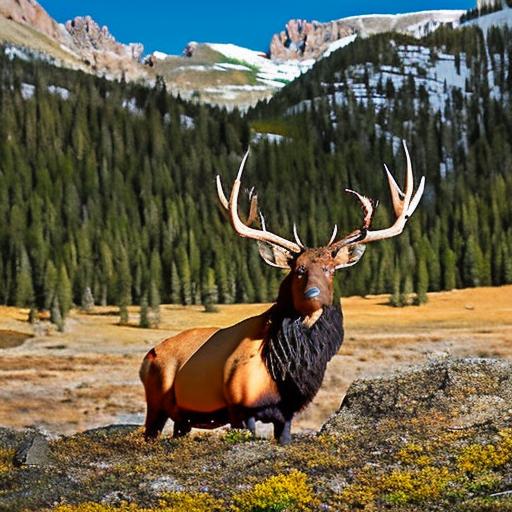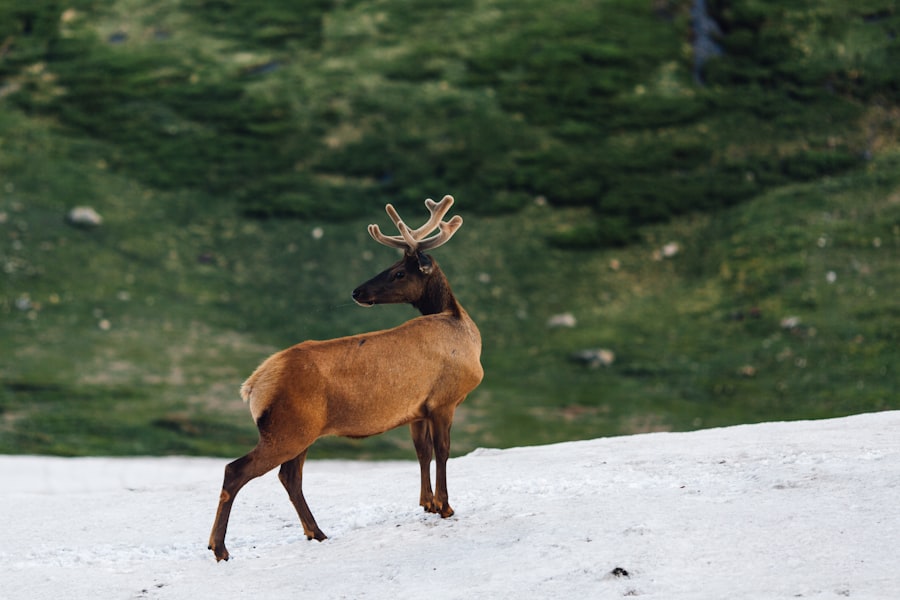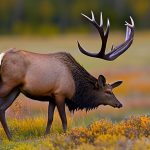Your cart is currently empty!

Chasing the Ultimate Trophy: My Archery Elk Hunt Adventure

Elk hunting is a thrilling and challenging adventure that many outdoor enthusiasts are drawn to. The pursuit of these majestic creatures in their natural habitat requires skill, patience, and a deep appreciation for the wilderness. In this blog post, we will explore the world of elk hunting and share tips and experiences to help you make the most of your own hunting adventures.
Key Takeaways
- Proper gear, training, and mental preparation are crucial for a successful elk hunt.
- Tracking elk in the wilderness is thrilling but requires patience and skill.
- Weather challenges and survival tactics must be considered when hunting in the elements.
- Perfecting archery technique and aim is an art that takes practice and dedication.
- Setting goals and finding the right elk is key to achieving the ultimate trophy.
Preparing for the Hunt: Gear, Training, and Mental Preparation
Preparing for an elk hunt is crucial to ensure a successful and enjoyable experience. One of the first steps is to gather the right gear. This includes a reliable rifle or bow, appropriate clothing for the weather conditions, sturdy boots, and essential accessories such as binoculars and a backpack. It is important to invest in high-quality gear that will withstand the rugged terrain and harsh weather conditions often encountered during elk hunts.
In addition to having the right gear, physical training is essential for elk hunting. The terrain can be challenging, requiring stamina and strength to navigate through steep slopes and dense forests. Regular exercise, such as hiking or running, can help build endurance and prepare your body for the physical demands of the hunt.
Mental preparation is equally important. Elk hunting requires patience and focus, as it can often involve long hours of waiting and tracking. Developing mental resilience and staying focused during the hunt can greatly increase your chances of success. Meditation or visualization exercises can help calm your mind and improve concentration.
The Thrill of the Chase: Tracking Elk in the Wilderness
One of the most exhilarating aspects of elk hunting is tracking these magnificent animals in their natural habitat. The thrill of following fresh tracks through dense forests or spotting a herd from a distance is unmatched. Tracking elk requires keen observation skills and an understanding of their behavior patterns.
When tracking elk, it is important to move quietly and slowly, paying attention to any signs of their presence, such as broken branches or fresh droppings. Elk are known for their acute senses, so it is crucial to stay downwind and avoid making sudden movements or loud noises that could alert them to your presence.
Personal experiences in tracking elk can vary greatly, but one common tip is to be patient and persistent. Elk are elusive creatures and can cover vast distances in a short amount of time. Tracking them requires dedication and a willingness to put in the effort to follow their trail.
Facing the Elements: Weather Challenges and Survival Tactics
| Weather Challenge | Survival Tactics | Metrics |
|---|---|---|
| Extreme Heat | Stay hydrated, wear light-colored and loose-fitting clothing, seek shade | Temperature, humidity, heat index |
| Extreme Cold | Wear layers, cover extremities, stay dry, seek shelter | Temperature, wind chill, frostbite risk |
| Thunderstorms | Seek shelter indoors or in a vehicle, avoid tall objects and bodies of water | Lightning strikes, wind gusts, hail size |
| Tornadoes | Seek shelter in a basement or interior room, cover head and neck | Wind speed, tornado rating, path length |
| Hurricanes | Evacuate if necessary, secure property, stay informed | Wind speed, storm surge, rainfall amount |
Hunting elk often means facing a wide range of weather conditions, from scorching heat to freezing cold. It is important to be prepared for these challenges and have the necessary gear and knowledge to stay safe and comfortable.
In extreme heat, it is crucial to stay hydrated and protect yourself from the sun. Carrying plenty of water and wearing lightweight, breathable clothing can help prevent dehydration and heatstroke. It is also important to take frequent breaks in shaded areas and avoid overexertion.
On the other hand, hunting in cold weather requires proper layering and insulation. Dressing in layers allows you to adjust your clothing as needed to regulate body temperature. It is also important to wear waterproof and windproof outer layers to protect against rain, snow, and strong winds.
Survival tactics are essential when facing extreme weather conditions. Carrying a survival kit with essentials such as a compass, fire-starting tools, emergency shelter, and food can help ensure your safety in case of an emergency. It is also important to inform someone of your hunting plans and expected return time.
The Art of Archery: Perfecting Technique and Aim
Archery adds an extra level of challenge and skill to elk hunting. Mastering archery technique and aim is crucial for a successful hunt. It requires practice, patience, and a deep understanding of the mechanics involved.
One of the most important aspects of archery is proper form. This includes a consistent anchor point, a relaxed grip, and a smooth release. Practicing these fundamentals regularly can help improve accuracy and precision.
Another key factor in archery is understanding the anatomy of an elk. Knowing where to aim for a clean and ethical shot is crucial. The vital organs of an elk are located behind the shoulder, so aiming for this area ensures a quick and humane kill.
To improve aim, it is important to practice shooting from various distances and angles. This helps develop muscle memory and improves accuracy in real hunting situations. Additionally, practicing in different weather conditions can help simulate the challenges faced during an actual hunt.
The Ultimate Trophy: Setting Goals and Finding the Right Elk

For many hunters, the ultimate trophy is not just about the size of the antlers, but also the experience of pursuing a specific elk. Setting goals and finding the right elk to hunt adds an extra level of excitement and motivation to the hunt.
Setting goals can help focus your efforts and make the hunt more meaningful. Whether it’s harvesting a mature bull or simply enjoying the experience of being in nature, having a clear goal in mind can enhance your hunting experience.
Finding the right elk to pursue requires scouting and research. This involves studying maps, talking to local hunters or guides, and spending time in the field observing elk behavior. Understanding their patterns and habitat preferences can greatly increase your chances of encountering the right elk.
The Rush of the Shot: Adrenaline and Precision in the Moment of Truth
Taking the shot is often the most adrenaline-filled moment of an elk hunt. The rush of adrenaline can make it challenging to stay calm and focused, but it is crucial for making an accurate shot.
One tip for staying calm during this moment is to focus on your breathing. Taking slow, deep breaths helps calm your nervous system and improves focus. It is also important to trust your training and muscle memory. The countless hours of practice will kick in, allowing you to execute a precise shot.
Another important aspect of taking the shot is patience. It is important to wait for the right opportunity and ensure a clean and ethical shot. Rushing a shot can lead to wounded animals and unnecessary suffering.
Tracking and Retrieving: The Hunt Continues After the Shot
The hunt does not end after taking the shot. Tracking and retrieving the elk is an essential part of the hunting process. It requires careful observation, tracking skills, and perseverance.
After taking the shot, it is important to mark the location where the elk was last seen and wait for a period of time before beginning the tracking process. This allows the animal time to expire and reduces the risk of pushing a wounded elk further away.
When tracking an elk, it is important to look for signs such as blood trails, broken branches, or disturbed vegetation. Following these signs can lead you to the downed animal. It is also important to stay focused and patient during this process, as tracking can sometimes be challenging and time-consuming.
Once the elk is located, it is important to approach with caution and ensure that it is indeed deceased before approaching too closely. It is also crucial to field dress the animal as soon as possible to preserve the meat and prevent spoilage.
Lessons Learned: Reflections on Successes and Mistakes
Every hunting experience provides an opportunity for growth and learning. Reflecting on successes and mistakes can help improve future hunts and enhance your overall hunting skills.
One lesson often learned through experience is the importance of patience. Elk hunting requires waiting for the right opportunity and being patient during the tracking process. Rushing shots or pushing animals can lead to missed opportunities or wounded animals.
Another lesson often learned is the importance of being adaptable. Hunting conditions can change rapidly, requiring hunters to adjust their strategies accordingly. Being open to trying new techniques or exploring different areas can greatly increase your chances of success.
Reflecting on past hunts can also help identify areas for improvement. Analyzing shot placement, tracking skills, or gear choices can lead to adjustments that enhance future hunting experiences.
The Reward of the Hunt: Celebrating the Experience and the Meat
Celebrating a successful hunt goes beyond just harvesting an animal. It is about celebrating the entire experience and the connection to nature. It is also about enjoying the reward of the meat.
Elk meat is highly regarded for its flavor and nutritional value. It is lean, high in protein, and low in fat. Celebrating the hunt includes properly processing and preparing the meat for consumption.
Properly processing elk meat involves field dressing, quartering, and packaging it for transportation. It is important to handle the meat with care to prevent spoilage and ensure its quality.
Cooking elk meat requires a different approach than cooking beef or other meats. Due to its leanness, elk meat can easily become tough if overcooked. It is best cooked to medium-rare or medium doneness to preserve its tenderness and flavor.
The Call of the Wild: Returning to the Wilderness for Future Adventures
Elk hunting is not just a one-time experience; it is a lifelong passion that often calls hunters back to the wilderness for future adventures. The allure of being in nature, testing one’s skills, and experiencing the thrill of the chase keeps hunters coming back year after year.
Returning to the wilderness for future elk hunting adventures allows hunters to continue honing their skills and deepening their connection with nature. Each hunt provides new challenges and opportunities for growth.
It is important to continue pursuing your passion for elk hunting and sharing your experiences with others. Whether it’s through storytelling, mentoring new hunters, or advocating for conservation efforts, your passion can inspire others to embrace their own adventures in the wilderness.
Embracing the Adventure of Elk Hunting
Elk hunting is a thrilling and rewarding adventure that requires skill, patience, and a deep appreciation for the wilderness. By preparing properly, honing your skills, and reflecting on past experiences, you can make the most of your elk hunting adventures.
Embrace the adventure of elk hunting and continue to pursue your passion. The thrill of the chase, the connection with nature, and the satisfaction of a successful hunt are all part of the journey. So grab your gear, head into the wilderness, and let the adventure begin.
If you’re an avid hunter looking to expand your skills, you might be interested in our article on “How to Hunt Grouse Without a Dog.” Grouse hunting can be a thrilling and challenging experience, and this article provides valuable tips and techniques for those who prefer to hunt without the assistance of a dog. Whether you’re a beginner or an experienced hunter, this article will help you improve your chances of success in the field. Check it out here.
FAQs
What is archery elk hunting?
Archery elk hunting is a type of hunting where hunters use a bow and arrow to hunt elk.
When is the archery elk hunting season?
The archery elk hunting season varies by state, but typically runs from August to September.
What equipment do I need for archery elk hunting?
You will need a bow, arrows, broadheads, a quiver, a release aid, camouflage clothing, boots, binoculars, and a backpack.
Do I need a license to go archery elk hunting?
Yes, you will need a hunting license and a tag specific to elk hunting. These can be obtained from the state wildlife agency.
Where can I go archery elk hunting?
Archery elk hunting is typically done in western states such as Colorado, Montana, Wyoming, and Idaho.
What is the success rate for archery elk hunting?
The success rate for archery elk hunting varies by state and location, but typically ranges from 10-30%.
Is archery elk hunting dangerous?
Hunting in general can be dangerous, but if proper safety precautions are taken, archery elk hunting can be done safely.
What should I do if I successfully hunt an elk?
If you successfully hunt an elk, you should field dress it and transport it to a processing facility or butcher as soon as possible.

Herb has been a longtime lover of the outdoors. Whether it be hunting, camping, fishing or just getting outside to reset. Proud father and animal lover. Bourbon anyone?

by
Tags:
Comments

Categories
- Big Game Hunting (301)
- Deer (202)
- Reviews (3)
- Shooting (16)
- Slingshot (1)
- Small Game Hunting (42)
- Upland Hunting (126)
- Waterfowl Hunting (3)





Leave a Reply